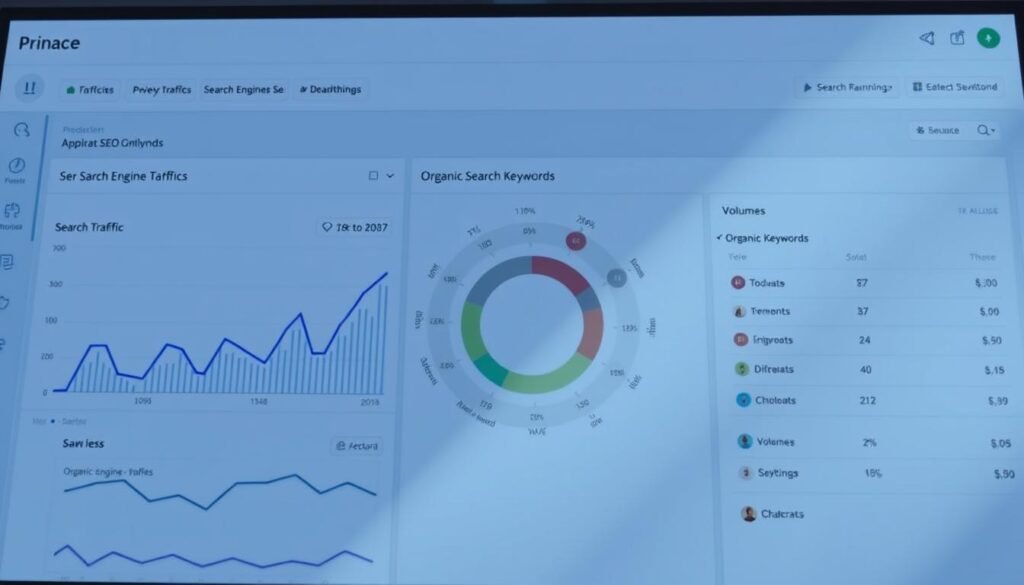In today’s digital world, a robust online presence is vital for businesses to succeed. An astonishing 93% of online experiences start with a search engine. This highlights the need for companies to optimize their websites for search engines.
Expert search engine optimization can greatly boost a website’s visibility. It drives more traffic and attracts more customers. By using proven SEO strategies, businesses can outshine their rivals and meet their online objectives.
Key Takeaways
- Understanding the importance of SEO for online visibility
- Leveraging expert SEO to drive more traffic to your website
- Staying ahead of competitors with proven SEO strategies
- Enhancing your online presence with optimized website content
- Achieving online goals through effective SEO techniques
Understanding Search Engine Optimization Fundamentals
In today’s digital world, knowing the basics of SEO is vital for businesses. Search engine optimization (SEO) is key to making a website more visible in search results. This is essential for any business aiming to be found online.
What Is SEO and Why It Matters
SEO encompasses various techniques and strategies to improve a website’s ranking in search engine results pages (SERPs). By optimizing a website for search engines, businesses can boost their online presence. This leads to more traffic and higher conversions. Effective SEO is about understanding what search engines want and delivering it.
The Business Impact of Strong SEO
A robust SEO strategy significantly impacts a business. It enhances brand awareness, credibility, and market competitiveness. By ranking high in search results, businesses gain customer trust and stay competitive.
Short-Term vs. Long-Term SEO Benefits
While some SEO benefits are immediate, like website usability improvements, the full impact is long-term. Long-term SEO efforts result in sustained rankings, consistent traffic, and ongoing conversions. Patience and persistence are key to lasting SEO success.
| SEO Benefits | Short-Term | Long-Term |
|---|---|---|
| Improved Website Usability | Yes | Yes |
| Sustained Rankings | No | Yes |
| Consistent Traffic | No | Yes |
Understanding SEO basics is critical for businesses aiming to boost their online presence. By mastering SEO fundamentals and applying effective techniques, businesses can increase visibility, drive more traffic, and meet their online objectives.
Essential Components of a Successful SEO Strategy
Creating a winning SEO strategy requires a blend of technical optimization, high-quality content, and a focus on the user. A well-rounded SEO plan is vital for boosting a website’s visibility and driving organic traffic.
Technical SEO Elements
Technical SEO is the foundation of any successful SEO strategy. It involves optimizing a website’s backend infrastructure to enhance its visibility in search results. This includes optimizing site architecture, creating XML sitemaps, and implementing schema markup.
Content Quality and Relevance
High-quality, relevant content is key to attracting and engaging target audiences. Content that provides value to users is more likely to be shared and linked to. This can significantly boost a site’s authority and search engine rankings.
User Experience Factors
User experience is critical in determining a website’s SEO success. Factors like page load speed, mobile-friendliness, and overall usability contribute to a positive user experience.
Page Load Speed and Core Web Vitals
Page load speed is a critical factor in user experience and SEO. Google’s Core Web Vitals, including metrics like Largest Contentful Paint (LCP) and Cumulative Layout Shift (CLS), are now key ranking factors.
Mobile-Friendliness and Responsive Design
With most internet users accessing websites on mobile devices, having a mobile-friendly, responsive design is essential. It’s not just optional; it’s a must for providing a good user experience and is now a key SEO ranking factor.
By focusing on these essential components, businesses can create a robust SEO strategy that drives results.
Conducting Effective Keyword Research
Understanding what keywords your target audience uses is vital for SEO success. Effective keyword research is key to a successful SEO strategy. It helps businesses identify relevant keywords and phrases their target audience uses.
Identifying Your Target Audience
Before diving into keyword research, it’s essential to identify your target audience. Understanding their needs, preferences, and search behaviors is critical. This helps tailor your keyword strategy to their expectations. Analyze your customer base, conduct surveys, and use social media listening tools to gain insights into their interests and pain points.
Tools for Keyword Discovery
Various tools can aid in keyword discovery, ranging from free to premium solutions. These tools help find relevant keywords, analyze competition, and identify search volume.
Free Keyword Research Tools
Some popular free keyword research tools include:
- Google Keyword Planner
- Ubersuggest
- Keyword Tool
Premium Keyword Research Solutions
For more advanced features, consider premium tools like:
- Ahrefs
- SEMrush
- Moz Keyword Explorer
Analyzing Keyword Competition and Search Volume
Once you’ve identified possible keywords, it’s critical to analyze their competition and search volume. This step helps you prioritize keywords that are likely to drive traffic to your site.
Long-Tail Keywords Strategy
Focusing on long-tail keywords can be an effective strategy. These are more specific phrases with lower competition and higher conversion rates.
Keyword Clustering Techniques
Keyword clustering involves grouping related keywords together. This technique helps create targeted content that addresses multiple related search queries. It improves your chances of ranking higher in search engine results.
By conducting thorough keyword research and analyzing your findings, you can develop an SEO strategy that resonates with your target audience. This drives meaningful traffic to your website.
On-Page Optimization Techniques
To enhance your website’s search engine ranking, it’s vital to master on-page optimization techniques. This involves adjusting elements on a webpage to boost its ranking and increase traffic. On-page optimization is key to improving your site’s visibility online.
Optimizing Title Tags and Meta Descriptions
Title tags and meta descriptions are critical in on-page optimization. The title tag should be concise, include the primary keyword, and not exceed 60 characters. Meta descriptions should offer a brief summary of the page content, be around 155-160 characters, and include a call-to-action. Effective title tags and meta descriptions can significantly improve click-through rates from search engine results.
Creating SEO-Friendly URL Structures
An SEO-friendly URL structure is essential for both users and search engines. URLs should be brief, include target keywords, and be easy to read. Avoid unnecessary numbers and special characters. A well-structured URL can improve the crawlability and indexing of your website.
Implementing Header Tags Effectively
Header tags (H1-H6) are used to structure content and highlight important keywords. The H1 tag should be the main title, with H2-H6 tags for subheadings. Proper use of header tags enhances readability and helps search engines understand content hierarchy.
H1-H6 Hierarchy Best Practices
Maintaining a logical hierarchy with header tags is critical. The H1 tag should be the main title, followed by H2 for subheadings, and so on. This structure organizes content and boosts SEO.
Incorporating Keywords in Headers
Including relevant keywords in header tags can enhance SEO. Yet, it’s important to maintain a natural flow and avoid keyword stuffing. Headers should be descriptive and provide a clear overview of the content.
Image Optimization Best Practices
Image optimization is a critical aspect of on-page SEO. This includes optimizing alt text, file names, and compressing images.
Alt Text and File Names
Using descriptive alt text and file names that include target keywords can improve image search rankings. Alt text also enhances content accessibility.
Image Compression and Formats
Compressing images reduces file size, improving page load times. Choosing the right image format (e.g., JPEG, PNG, WebP) can also impact performance. Optimized images can enhance user experience and contribute to better SEO.

| On-Page Element | Best Practice | SEO Benefit |
|---|---|---|
| Title Tags | Include primary keyword, be descriptive | Improved search engine ranking |
| Meta Descriptions | Provide summary, include call-to-action | Better click-through rates |
| URL Structure | Concise, include target keywords | Improved crawlability and indexing |
| Header Tags | Use H1-H6 hierarchy, include keywords | Enhanced content structure and SEO |
| Image Optimization | Use descriptive alt text and file names, compress images | Improved image search rankings and page load times |
Creating High-Quality Content for Search Engine Optimization
In the world of search engine optimization, the value of high-quality content is immense. Content that is both relevant and authoritative is key to boosting search rankings and engaging users.
Developing a Content Strategy
A well-thought-out content strategy is essential for SEO success. It requires understanding your audience and crafting content that fulfills their needs.
Content Calendars and Planning
Using a content calendar is vital for organizing and scheduling content. It ensures your content remains consistent and relevant.
Content Types That Drive SEO Results
Different content types, like blog posts, articles, and infographics, can significantly impact SEO. The goal is to find the types that resonate most with your audience.
Writing SEO-Optimized Content
Creating content optimized for search engines demands a delicate balance. It’s about crafting content that is both informative and engaging.
Keyword Placement and Density
Effective keyword placement and density are critical for SEO. Keywords should be integrated naturally, appearing in titles, headings, and meta descriptions.
E-A-T Principles in Content Creation
The E-A-T principles (Expertise, Authoritativeness, Trustworthiness) guide Google in evaluating content quality. Adhering to these principles can elevate your content’s credibility and ranking.
Content Formatting for Better Readability
Improving content readability involves strategic formatting. Using headings, subheadings, bullet points, and short paragraphs enhances user experience and search engine understanding.
Here are some essential formatting tips:
- Employ clear and concise headings
- Divide long paragraphs into shorter ones
- Use bullet points for lists
- Ensure proper spacing between sections
Off-Page Optimization Strategies
To boost your website’s visibility, implementing effective off-page optimization strategies is key. Off-page optimization includes actions outside your website to enhance its search engine ranking. This includes building high-quality backlinks.
Building High-Quality Backlinks
Securing high-quality backlinks is vital for off-page optimization. It means getting links from authoritative and relevant sites. This boosts your website’s credibility and ranking.
Guest Posting and Outreach Techniques
Guest posting and outreach are powerful for building backlinks. By creating valuable content for other reputable sites, you earn links back to yours. This enhances your backlink profile and increases brand visibility.
Identifying Link-Building Opportunities
Finding link-building opportunities is essential for a successful backlink strategy. This involves researching relevant sites, analyzing their content, and finding ways to contribute value for a link.
Social Media Signals and SEO
Social media signals can indirectly affect your website’s SEO by driving traffic and boosting engagement. While they’re not a direct ranking factor, a strong social media presence enhances overall online visibility.
- Increase brand awareness through social media platforms.
- Drive traffic to your website using social media advertising.
- Engage with your audience to build brand loyalty.
Local SEO Tactics
For businesses targeting a local audience, local SEO tactics are critical. This includes optimizing your Google Business Profile and getting listed in local directories.
Google Business Profile Optimization
Optimizing your Google Business Profile is vital for local SEO. Make sure your profile is complete, accurate, and up-to-date. Include your business hours, address, and contact information.
Local Citations and Directories
Getting listed in local citations and directories boosts local search visibility. Ensure your business’s name, address, and phone number (NAP) are consistent across all listings.

Technical SEO Implementation
A well-implemented technical SEO strategy is essential for a website to rank higher in search results. Technical SEO involves optimizing a website’s backend to improve its visibility. This includes enhancements in website speed and ensuring mobile optimization.
Improving Website Speed and Performance
Website speed is a critical factor in search engine ranking. A faster website improves user experience and is favored by search engines.
Server Optimization Techniques
Optimizing server response time is key. Techniques include using a content delivery network (CDN) and optimizing server software.
Resource Minification and Caching
Minifying CSS, JavaScript, and HTML files reduces their size. Caching allows frequently-used resources to be stored locally in a user’s browser.
Mobile Optimization Essentials
With the majority of searches now conducted on mobile devices, ensuring a website is mobile-friendly is critical.
Mobile-First Indexing Requirements
Google’s mobile-first indexing means the mobile version of a website is considered primary. Ensuring it is responsive and loads quickly is essential.
Accelerated Mobile Pages (AMP)
AMP is an open-source initiative for creating lightweight, fast-loading web pages. It’s useful for news sites and blogs.
Structured Data and Schema Markup
Structured data helps search engines understand webpage content. It enables rich snippets and other enhanced search results.
Rich Snippets and Featured Results
Rich snippets provide additional information about a webpage in search results. This improves click-through rates.
Implementing JSON-LD
JSON-LD is a method of encoding linked data using JSON. It makes schema markup implementation easier on a website.
| Technical SEO Aspect | Description | Benefit |
|---|---|---|
| Website Speed | Optimizing server response time and resource minification | Improved user experience and search engine ranking |
| Mobile Optimization | Ensuring a responsive, fast-loading mobile site | Better search engine ranking and user engagement |
| Structured Data | Implementing schema markup using JSON-LD | Enhanced search results and improved click-through rates |
Measuring and Analyzing SEO Performance
To gauge the success of your SEO strategy, it’s essential to measure and analyze its performance regularly. This involves tracking key metrics and utilizing SEO analysis tools to understand the impact of your efforts.
Key SEO Metrics to Track
Tracking the right metrics is essential for understanding your SEO performance. Two critical areas to focus on are:
Organic Traffic and Conversion Metrics
Monitoring organic traffic helps you understand how many visitors are reaching your site through search engines. Conversion metrics, such as form submissions or purchases, indicate the effectiveness of your SEO in driving meaningful actions.
Ranking Position Tracking
Keeping an eye on your ranking positions for target keywords helps you assess the success of your SEO efforts in improving visibility and driving relevant traffic.
Tools for SEO Analysis
Several tools can help you analyze your SEO performance. Notable among these are:
Google Analytics and Search Console
Google Analytics provides insights into your website’s traffic, engagement, and conversion metrics. Search Console offers data on search queries, impressions, and clicks, helping you understand your site’s performance in search results.
Third-Party SEO Analytics Platforms
Tools like Ahrefs, SEMrush, and Moz offer detailed SEO audits, backlink analysis, and keyword tracking. They provide a more detailed view of your SEO performance.
Adjusting Your Strategy Based on Data
Once you have analyzed your SEO performance, it’s essential to adjust your strategy. This can involve:
A/B Testing for SEO
A/B testing different elements of your SEO strategy, such as title tags or meta descriptions, can help you identify what works best for your audience.
Competitive Analysis Techniques
Analyzing your competitors’ SEO strategies can provide valuable insights into gaps and opportunities in your own approach.

Conclusion: Taking Your SEO to the Next Level
As we wrap up our SEO discussion, it’s clear that continuous optimization is key to keeping and boosting your online presence. We’ve covered the basics of search engine optimization, from technical aspects to content quality and user experience.
Effective SEO strategies blend on-page and off-page techniques. On-page includes optimizing title tags, meta descriptions, and URL structures. Off-page focuses on building quality backlinks and using social media to your advantage.
To elevate your SEO, keep a close eye on your performance. Track important metrics, use SEO analysis tools, and tweak your strategy with new insights. This approach helps refine your SEO and enhances your online visibility.
In summary, SEO is a continuous journey, not a one-off task. By keeping abreast of SEO trends and best practices, you can maintain a competitive online presence and see it grow.
Sources
To deepen your knowledge and stay current with SEO trends, check out these reference links.
- Moz – A leading resource for SEO insights and guides.
- Search Engine Land – Offers news, analysis, and resources on SEO and digital marketing.
- Backlinko – Provides in-depth SEO tutorials and strategies.
- SEMrush – A tool for SEO audits, keyword research, and competitor analysis.
These sources provide essential information and tools to improve your grasp and application of effective SEO strategies.
FAQ
What is the primary goal of search engine optimization?
The main aim of search engine optimization is to boost a website’s visibility online. It aims to increase traffic by improving its ranking on search engine results pages.
How does keyword research impact SEO?
Keyword research is vital for SEO. It helps find the keywords and phrases people use to search for content, products, or services. This knowledge allows businesses to tailor their content for better search engine rankings.
What are some key on-page optimization techniques?
Important on-page optimization techniques include optimizing title tags, meta descriptions, and URL structures. Header tags and image optimization are also key. These practices help improve a website’s search engine rankings.
How does page load speed affect SEO?
Page load speed is a critical SEO factor. Slow websites harm user experience and rankings. Fast websites, on the other hand, enhance engagement and conversion rates.
What is the role of backlinks in off-page optimization?
Backlinks are vital in off-page optimization. High-quality backlinks from trusted sources boost a website’s credibility and trust. This can significantly improve search engine rankings, driving more traffic and increasing visibility.
How can businesses measure the success of their SEO efforts?
Businesses can gauge SEO success by tracking website traffic, search engine rankings, and conversion rates. Tools like Google Analytics and SEO analysis software help make data-driven decisions.
What is the importance of mobile-friendliness in SEO?
Mobile-friendliness is critical in SEO. It ensures a smooth user experience on all devices. This improves engagement, conversion rates, and search engine rankings. Search engines favor mobile-friendly websites.
